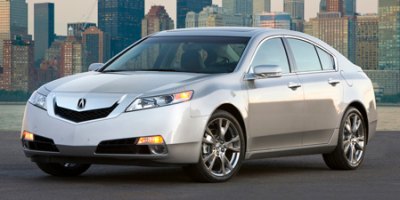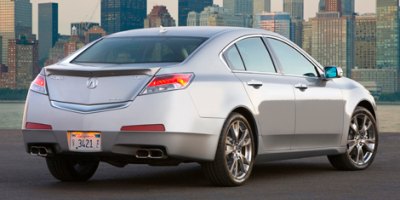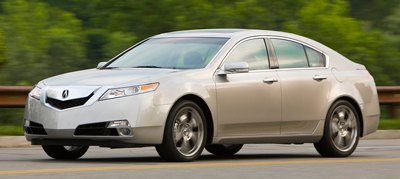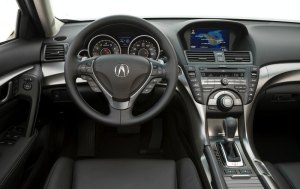|

|
If TL want to survive into the next
decade, it needs to deliver real premium quality and dynamics...
|
Acura
TL used to be a Honda Accord pretending to be a premium car - its heart
and bones had no differences from the America's second-best selling
family car, only a classier packaging lifted it above the workman
class. In the last 2 decades, this formula worked reasonably well in
the North America, where people care less about driving dynamics.
However, the world has changed a lot these days. Not only European
rivals (especially Audi) have upped their game, its Japanese
counterparts (Lexus IS and Infiniti G), American competitors (Cadillac
CTS and maybe Chrysler 300C) and Korean challenger (Hyundai Genesis)
have all invested heavily into rear-wheel drive platforms. If TL want
to survive into the next decade, it needs to deliver real premium
quality and dynamics.
Sadly, Honda once again refused to give it a dedicated platform. It
still wanted to save money by building it on the current American
Accord platform. It knew this platform is large, powerful and refined
enough for this task. What it can't match the competitions is handling,
which is inherently limited by its transverse-engine and front-wheel
drive structure. To make things look better, it decided to make two
versions of TL - one is the front-drive base car powered by Accord's
3.5-liter VTEC V6, which should start from US$34,000 and account for 75
percent of sales; another employs Acura RL's SH-AWD system and
3.7-liter VTEC V6, which will top US$42,000 and account for minority
sales. In other words, let the SH-AWD car to get favourable comments
from motoring journalists and fool the majority who will end up with
the base car. Clever.

|
Now as large as RL, it effectively
makes the Acura flagship redundant...
|
Based
on the jumbo-size new Accord, the new TL is considerably larger than
the old car - 150 mm longer, 45 mm wider, 13 mm taller and runs a 36 mm
longer wheelbase. Surprisingly, it is actually as large as the flagship
RL ! Despite the use of many high-strength steel parts and aluminum
components – the latter consist of bonnet, front subframe and rear
suspension knuckles – the car still sits at the heavy side of its
segment. A SH-AWD model tips the scale at as much as 1805 kg, while the
FWD model still weighs some 1680 kg. This works against the trend to
cut weight and fuel consumption. In return, its customers get a roomier
back seat and very good refinement on the road. Noise insulation and
suspension compliance match the standard of European premium cars. It
effectively makes the RL redundant. As we heard, the next RL will go
upmarket. The TL itself competes with both the high-end BMW 3-series
and low-end BMW 5-series.
The base TL's 3.5-liter SOHC V6 has VTEC variable valve timing and lift
mechanism on its intake valves. Max power and torque are 280 hp and 254
lb-ft respectively, which looks good on paper but its torque delivery
is peaky. Power goes to the front wheels through a 5-speed automatic
gearbox. The lack of ratios doesn't do any good to fuel consumption,
but at least its gearshift is smooth.

|
SH-AWD largely compensated the dynamic
weakness of the Accord platform, making it far more agile...
|
The
3.7-liter SOHC V6 has VTEC acting on both intake and exhaust valves.
Its 305 horsepower is barely enough to offset the extra weight over the
base model, while its 275 lb-ft of torque @ 5000 rpm comes neither
strong nor early enough. A BMW 535i produces 300 lb-ft of torque from
1400 rpm yet needs to cope with less weight. Similar case for new Audi
A6 3.0T. The Acura is not easy to please the torque-chasing American.
Best of the bunch is the SH-AWD system. We praised it in the original
Honda Legend report and we shall continue to praise it here. It could
deliver up to 70 percent torque to the rear wheels depending on
traction. Torque to each of the rear wheels can be altered by a
multi-plate clutch at the rear differential. No wonder the car displays
remarkably neutral handling accompany with superb traction. SH-AWD has
largely compensated the dynamic weakness of the Accord platform, making
it feel far more agile than its size and weight distribution suggested.
In fact, it is the best handling Acura / Honda sedan in the current
lineup. A BMW 335i is of course more fun to drive, but this is mainly
due to its compact size, stronger powertrain and more communicative
steering. The TL's steering, which has switched from hydraulic to
electric assistance, has lost communication with the blacktop. It is
also too light on-center for the taste of keen drivers.

|
The philosophy behind this car is
nonsense...
|
Predictably,
the base TL with front-wheel drive is no match with European premium
cars in dynamics. It doesn't like to be pushed in corners, therefore
instead of promoting a sporty character, Honda installed softer
springs, dampers and suspension bushings and higher profile tires to
the car to please civilized customers.
Unfortunately, the car is lost in the search of its character. If it
really want to lure civilized customers, it should not employ such a
controversial styling. Its interior should also be made simpler and
more initiative to use. It reflects the bad taste of its California
design studio. It reflects a "larger-is-better" philosophy that even
Detroit's Big Three are abandoning. It is made unnecessarily
inefficient and complicated, damaging the green commitment Honda shown
in other recent vehicles. The car itself is not bad to drive,
especially in top version, but the philosophy behind it is too nonsense
to me. |